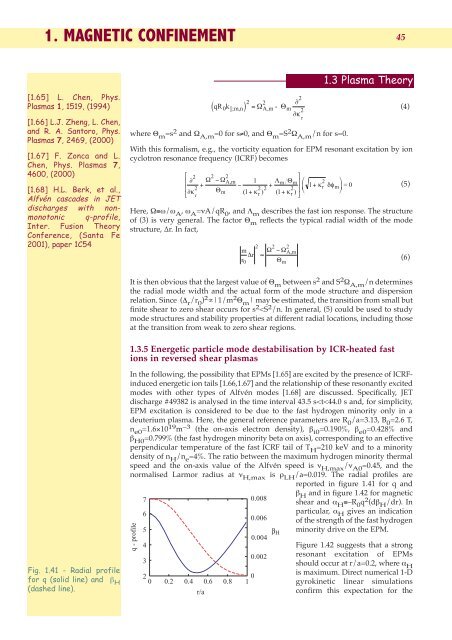1. magnetic confinement - ENEA - Fusione
1. magnetic confinement - ENEA - Fusione
1. magnetic confinement - ENEA - Fusione
You also want an ePaper? Increase the reach of your titles
YUMPU automatically turns print PDFs into web optimized ePapers that Google loves.
<strong>1.</strong> MAGNETIC CONFINEMENT<br />
45<br />
<strong>1.</strong>3 Plasma Theory<br />
[<strong>1.</strong>65] L. Chen, Phys.<br />
Plasmas 1, 1519, (1994)<br />
[<strong>1.</strong>66] L.J. Zheng, L. Chen,<br />
and R. A. Santoro, Phys.<br />
Plasmas 7, 2469, (2000)<br />
[<strong>1.</strong>67] F. Zonca and L.<br />
Chen, Phys. Plasmas 7,<br />
4600, (2000)<br />
[<strong>1.</strong>68] H.L. Berk, et al.,<br />
Alfvén cascades in JET<br />
discharges with nonmonotonic<br />
q-profile,<br />
Inter. Fusion Theory<br />
Conference, (Santa Fe<br />
2001), paper 1C54<br />
where Θ m =s 2 and Ω A,m =0 for s≠0, and Θ m =S 2 Ω A,m /n for s=0.<br />
With this formalism, e.g., the vorticity equation for EPM resonant excitation by ion<br />
cyclotron resonance frequency (ICRF) becomes<br />
⎡ 2 2 2<br />
⎤<br />
⎢ ∂ Ω − ΩAm<br />
, 1 Λm<br />
Θ<br />
+<br />
− + m⎥<br />
⎛<br />
⎢ 2<br />
2 2 2 ⎥ ⎜<br />
⎣∂κ Θm<br />
( 1+<br />
κr<br />
) ( 1+<br />
κ ⎝<br />
r ) ⎦<br />
r<br />
2<br />
2 2 ∂<br />
qR0k||; mn , Am , - m 2<br />
∂κ<br />
r<br />
( ) = Ω Θ<br />
Here, Ω≡ω/ω A , ω A =νA/qR 0 , and Λ m describes the fast ion response. The structure<br />
of (3) is very general. The factor Θ m reflects the typical radial width of the mode<br />
structure, ∆r. In fact,<br />
2 2 2<br />
m Ω − ΩAm<br />
,<br />
∆r<br />
≈<br />
r0<br />
Θm<br />
2 ⎞<br />
1+<br />
κr<br />
δφm⎟<br />
=0<br />
⎠<br />
(4)<br />
(5)<br />
(6)<br />
It is then obvious that the largest value of Θ m between s 2 and S 2 Ω A,m /n determines<br />
the radial mode width and the actual form of the mode structure and dispersion<br />
relation. Since (∆ r /r 0 ) 2 ∝|1/m 2 Θ m | may be estimated, the transition from small but<br />
finite shear to zero shear occurs for s 2













